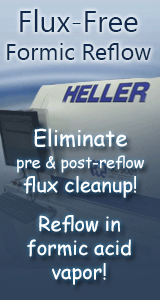Printed Circuit Board Assembly & PCB Design Forum
SMT electronics assembly manufacturing forum.
- SMTnet
- »
- Electronics Forum
- »
- Tombstoning
Tombstoning
![]() We are currently having gross tombstoning with 0402 capacito...
- Jun 12, 2002
by
EricD
We are currently having gross tombstoning with 0402 capacito...
- Jun 12, 2002
by
EricD
![]()
![]()
![]() Tough. 0402 capacitors are more prone to tomb stoning than ...
- Jun 12, 2002
by
davef
Tough. 0402 capacitors are more prone to tomb stoning than ...
- Jun 12, 2002
by
davef
![]()
![]()
![]() Check your land patterns. I believe someone once made a typ...
- Jun 12, 2002
by
Stephen
Check your land patterns. I believe someone once made a typ...
- Jun 12, 2002
by
Stephen
![]()
![]()
![]() Is this a new problem on an old product, or is this a first ...
- Jun 12, 2002
by
Steve T.
Is this a new problem on an old product, or is this a first ...
- Jun 12, 2002
by
Steve T.
![]()
![]()
![]() guys thanks for the suggestions...
DaveF,
*Changing pa...
- Jun 13, 2002
by
guys thanks for the suggestions...
DaveF,
*Changing pa...
- Jun 13, 2002
by
![]()
![]() >>*Changing paste
>EricD: Yes we are considering that as a ...
- Jun 13, 2002
by
davef
>>*Changing paste
>EricD: Yes we are considering that as a ...
- Jun 13, 2002
by
davef
![]()
![]()
![]() DaveF,
Yeah you got that right...because the initial stag...
- Jun 14, 2002
by
DaveF,
Yeah you got that right...because the initial stag...
- Jun 14, 2002
by
![]()
![]() There is no real reason why you shouldn�t use your current p...
- Jun 14, 2002
by
davef
There is no real reason why you shouldn�t use your current p...
- Jun 14, 2002
by
davef
![]()
![]()
![]() A good PDF-file about tombstoning, written by Plexus, is acc...
- Jun 15, 2002
by
A good PDF-file about tombstoning, written by Plexus, is acc...
- Jun 15, 2002
by
![]()
![]() well we can't paste the flip chip on its substrate because w...
- Jun 15, 2002
by
EricD
well we can't paste the flip chip on its substrate because w...
- Jun 15, 2002
by
EricD
![]()
![]()
![]() I don't understand "well we can't paste the flip chip on its...
- Jun 17, 2002
by
davef
I don't understand "well we can't paste the flip chip on its...
- Jun 17, 2002
by
davef
![]()
EricD
- SMTnet
- »
- Electronics Forum
- »
- Tombstoning







